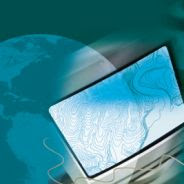 Conceptual System Design
Conceptual System Design
During the system analysis, the analysis of system data is very important. Analysis of data is made up of more than one level at the beginning (first level) and different ideas are used at each level. At first level, analyst develops a conceptual system design.
Since the conceptual design sets the direction for the management information system (MIS). It is vital that managers participate seriously and heavily at this stage. Conceptual design is sometimes called feasibility design, gross design or high level design.
The conceptual design phase takes as input.
1. A crisp statement of a management information requirement and
2. a set of management objectives for the MIS
In the conceptual design stage that the alternative overall MIS designs are conceived and the best one is selected by the system analyst in consultation with the top management. The feasibility of meeting the management objectives for the MIS is assessed showing how the system will work at the high level is drawn. Therefore, conceptual design is also known as gross design; high level becomes the basis for the detailed MIS design.
Hence, conceptual design is a pre-design for the detailed design. In fact, conceptual design is the “centerpiece” of the process. Only after conceptual design is completed, it can be sure that the MIS can successfully be constructed.
The conceptual design involves the following tasks.
1. Defining problems in more details.
2. Refining the management objectives to set system objectives.
3. Establishing system constraints.
4. Determining information needs and their sources.
5. Developing alternative designs and selection one from these various designs.
6. Document the conceptual design and preparing the report.
1. Define the problem-
There is no doubt that problems exists in any dynamic business. The most important is that what are usually lacking are clear definitions of the problems and the priority system on the basis of problem is the main solution. Therefore, management must take the first step in MIS design by formulating problems to be solved. The problem can be solved by the iterative process.
The goal for the business leads to the objectives of the general business. From the objectives, plans are derived. Each business objectives and business plans are derived. Each business objectives and business plans are associated with information needs. These Information needs are the problems to be solved by the MIS function. The statements of needs are enough for designing process.
1. Stating the information need.
2. Asking questions about that need.
3. Suggesting interpretation of that need.
4. Detailing the original statement.
5. Reviewing the more detailed statement of need with management.
These steps are repeated until the information needs and the problem to be solved are really understood. The process of problem refinement flows naturally into the system objectives.
2. Set System Objectives
Most of the time it is quite difficult to state objectives for systems that covers all the functional areas.
The manager must define the system objectives in terms of the importance of information demands and not in terms of the satisfaction of demands that are not related to an objective. System analyst tends to stress processing efficiency and staff and functional supervisors commonly believe that their objective is “to complete the required report in time for management use”. This view disregards the real objectives of the system design, management’s effectiveness.
The value of system lies in the benefits of the users. When we ask for the objectives, a college principal may reply,” provide quality education” and a government bureaucrat may say” provide more jobs for the unemployed”. Despite its difficulty being specific is necessary. System objectives should be expressed in terms of what managers can do after their information requirements have been met.
In summary, the first steps in systems design attempts to answer the question” what is the purpose of the system?” why it is needed? What is it expected to do? Who are the users what are their objectives?
3. Establish System Constraints
The iterative nature of the systems design process is easily understood when we consider the third step in the process-establishing constraints. It can also be called as problem boundaries or restrictions, constraints enable the designer to stipulate the conditions under which objectives may be attained and to consider the limitations that restricts the design. The two steps of setting objectives and establishing constraints may be considered together as one.
Constraints may be viewed as a negative limitation on systems design, there is a positive benefit also. Establishing constraints will help to ensure that the design is realistic.
Constraints may be classified as external or internal to the organization.
External Constraints
The external environment of the organization is concerned by the customer. Order entry, billing and other systems that interface with the customer’s needs in mind. If some outputs from the system are not acceptable to the customer, a definite limitation must be faced up.
The government imposes certain restrictions on the processing of data. That may be the need to maintain the security of certain classes of information to comply with law and regulation in the conduct of business (e.g. taxes, reporting).
Unions can also affect the operations of systems involving members in working conditions.
Suppliers are also an important group to be considered when designing information systems because these systems frequently interface with that group.
Internal Constraints
If top management support is not obtained for the systems concept and for the notion that computer based information systems are vital for management planning and control, the type of design effort cannot be implemented. A good environment for information systems must be set, and one essential requirement is the approval and support of the top management.
Organizational and policy considerations frequently set limit on objectives and modify an intended approach to design of the system. Company policies frequently define or limit the approach to systems designs.
Personnel needs and personnel availability are a major limiting factor in both the design and utilization of information systems. Computer and systems skills are among the most critical in the nation. The most significant constraint of all is the one concerning the people.
Cost is a major resource limitation. The cost to archive the objectives should be compared with the benefits to be derived.
Self-imposed restrictions are these placed on the design by the manager or the designer. The manager will also restrict the amount of time and effort devoted to investigation. To achieve the objective, the manager may have to scale down several requirements to make the system fit with other outputs, equipments or constraints.
4. Determining Information needs and sources
For a good system design, a clear statement of information needs is very important and necessary. Many organizations spend huge amounts on hardware and software to maintain existing systems or build sophisticated data banks, without first determining the real information needs of management: the information that can increase the ability of managers in critical areas such as problems, alternatives, opportunities and plans.
The optimum results cannot be achieved unless managers can provide the specifications for what they want out of an information system. The manager needs information for variety of reasons concerned with the management process. The type of needs at various times and various purposes depends largely upon two factors.
a) The personal managerial attributes of the individual manager and
b) The organizational environment in which decisions are made.
The information sources are important for determining information needs. The system may require external information or the internal.
5. Alternative conceptual designs and selecting one
The development of a concept of a system is a creative process that involves synthesizing knowledge into some particular pattern. The concept of an MIS would consist of the major decision points, patterns of information flow, channels of information and roles of managers and competitors. The concept is the sketch of the structures or skeleton of the Information System, which guides and restricts the form of the detailed design. If conceptual design is the skeleton, then detailed design is the flesh.
E.g. two teams of students are trying to do project on the tourist guide and contact information system. One concept produced is a sketch showing a detail about the particular places describing its culture, heritages along with the colleges. Hotels and trade. Where as another team produces a sketch of description of colleges along with the description of faculty and the fee structures on various needs.
It is obvious that each alternative concept of a system has advantages and disadvantages. Sometimes one concept will dominate all others by major criteria.
6. Document the best design
Sufficient information has been accumulated to begin a more detailed description of the system concept. This description includes essentially a flowchart or other documentation of the flow of information through the system, the inputs and the outputs.
The manager should be involved to the extent that the system provides the information required, the designer is concerned with the nature of the materials and equipment as well as with technical processing considerations.
Details to be worked out later by the designer will include exact instructions as what data are to be captured and when, the files are to be used, the details of how processing is to be done, what outputs will be generated by the system etc.



















